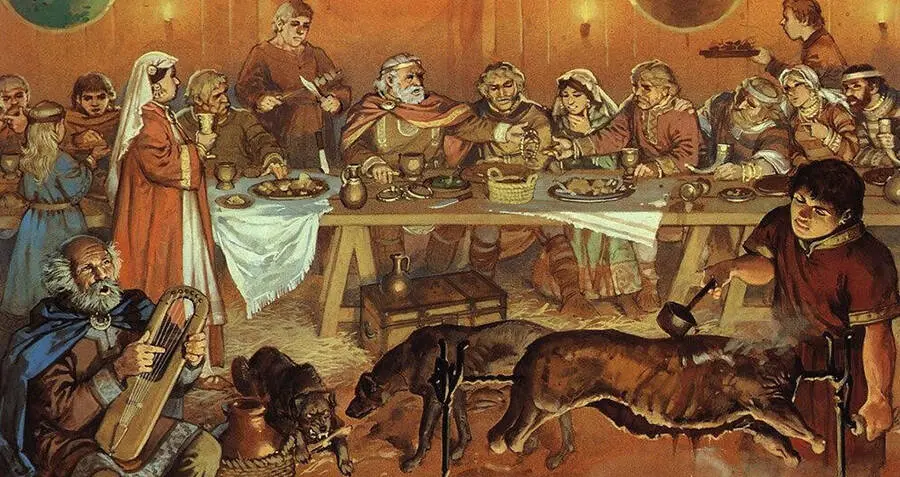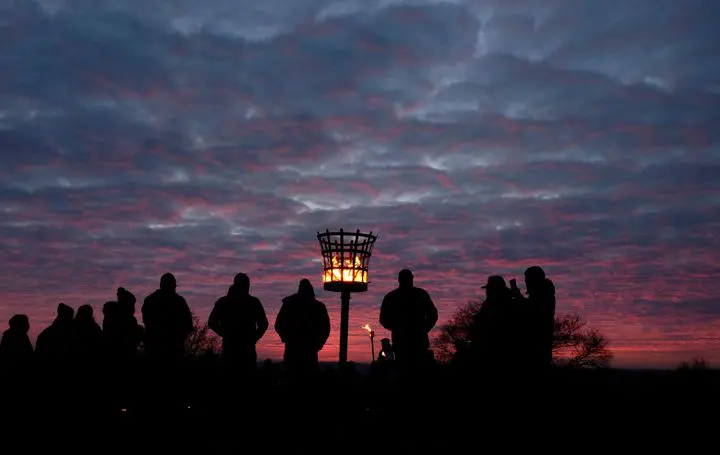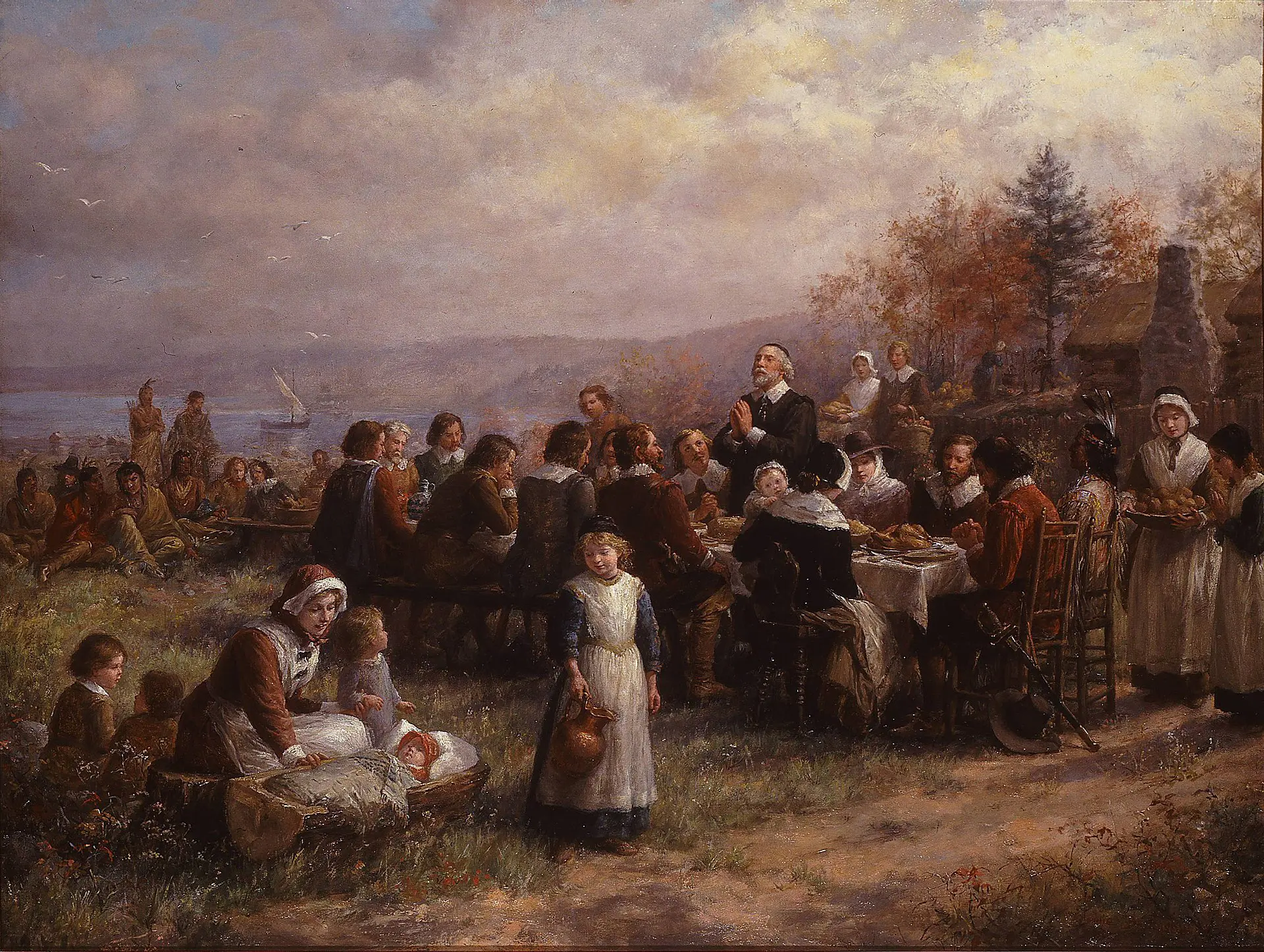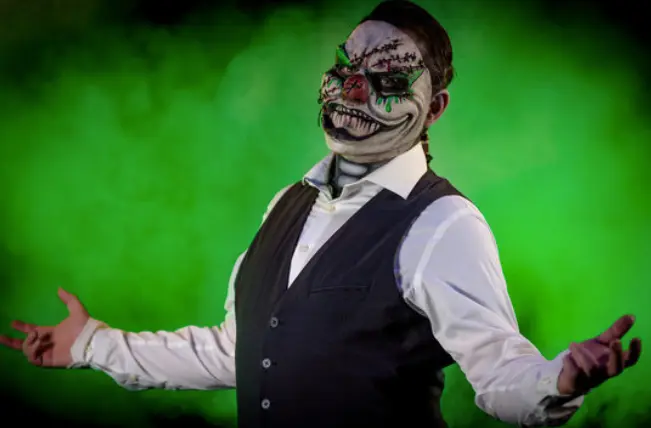The Thule Society Wishes You Merry Yuletide and Happy New Years!
THOUGHTS ON THE HOLIDAY SEASON
Part One – Christmas & Yuletide (Untangling Fact from Fiction):
The well-known reality is that Christmas was never really about the supposed birth of the fanciful character known as Jesus Christ. Jesus Christ appears as the alleged “Son of God” in the famous work of fantasy-fiction which is commonly called The Bible.
The Holiday called Yuletide only became identified with the literary invention of Jesus Christ after the violent and bloody suppression of an older pagan holiday called The Festival of Yuletide. The Festival of Yuletide was adopted by Christianity because attempts to suppress Yuletide among the Germanic and Celtic peasantry had failed. Christian attempts to suppress the pagan Yuletide Festival failed because this festival had been a big part of old pre-Christian pagan culture for untold generations; thus, the peasantry was very devoted to observing this holiday. After attempts to suppress Yuletide had failed, The Catholic Church changed the festival’s meaning into a celebration for the birth of a character named Jesus Christ.

Image of an old-time Yuletide celebration dinner furnished courtesy of allthatisinteresting.com
The official story of Jesus Christ’s birth took place in the Fall of the year, but it is easy to be malleable with the facts when an incident never happened anyway and the principal character in that fictitious story never existed. As for Yuletide, The Roman Church wanted to Christianize a greatly loved pagan festival that those pesky peasants just refused to stop celebrating despite the most brutal methods being used to try and stamp out their dirty little holiday.
Concerning the Christmas Holiday as it is celebrated today, you basically have a Heathen festival that uses Heathen symbols which is being given a Christian name and a Christian justification for its existence. “Jesus is the Reason for the Christmas season?” Nope! The old pagan Yuletide holiday has simply been given Jesus’s name. So, should the Christianized version of the old Yuletide Holiday be called Christmas or Xmas? This question is really stupid because X-mas is the name for this holiday that is used by the Greek Orthodox Church with “X” being the first letter in “Jesus” (“Xesus”) when this name is written in the Greek language.

Image courtesy of sudbury.com
The Timing of Yuletide
With the Teutons (Ancient Germans), Yuletide was observed on what the old Germans considered their version of New Years Day. For the old German pagans, their New Years holiday began on the day after the shortest day of the year when the days begin to lengthen once more, and Spring begins to slowly approach once again. Considering the fierce winters that were experienced by the more northern parts of Europe in ancient times, the shortest day of the year was a very important day to make note of.

Image courtesy of Irene Horrors on deviantart.com

Old Yultetide celebrations were often marked by costumes being worn. image courtesy of Forest_Mother on X.com

Image courtesy of oldeuropeanculture.blogspot.com

Image courtesy of HuffPost.com
For old Germanic pagans, the first day that marks the sun’s return during the dead of winter was seen as a time to give thanks to the higher spirits for helping the people to make it through the year safely thus far. The Yuletide Holiday was also seen as a time to give thanks to the Higher Spirits for helping The Folk to reach the better times ahead during the upcoming days of Spring and Summer. The Celts also observed Yuletide, but they did not consider this day to be their New Years holiday because the they celebrated the Samhain holiday as their New Years festival.
Teutonic Elements of Yuletide:
(1) Yuletide Tree |
Being an evergreen tree, the Yuletide tree is preferably a cedar, but most-commonly the tree used is a Fir, and if necessary, some other type of pine tree such as a Radiata pine will suffice. An evergreen Yuletide tree represents life that endures and flourishes regardless of its surrounding conditions.
(2) Fertility Symbols |
(a) Ornaments originally decorated Eggs that were hung on Yuletide trees to promote fertility for women who were planning to get pregnant in the coming year.
(b) Tinsel originally representing Semen, so tinsel was traditionally hung up as a decoration by men who intended to sire offspring in the coming year.
(3) Reindeer |
These members of the deer family did not occur in the lands of the Teutons or the Celts, but they were native to the lands of the Balts who are Aryan cousins of the Teutons and Celts. These very necessary helpers proliferated into vast and easily domesticated herds, so they were considered fertility symbols by the Balts.

Image above courtesy of ChovahaniArt on Etsy.com
(4) Santa Klaus|
Santa Klaus, or whatever other names one chooses to use for this character, are all just sobriquets for ODIN THE ALL-FATHER. The common Santa Klaus costume that is marked by its red color and its internal lining of fur is what Odin used to wear during Yuletide when he went around visiting people. If you were fortunate, or if you were unfortunate, as the case may be, then you just might have been visited by Odin during the Yuletide holiday. Odin always expected to be treated with impeccable hospitality whenever he visited a an individual person’s home or a group of people’s home, but being treated with the highest level of respect by whomever he visited was Odin’s rightful due considering who he is.

Image courtesy of KristinaLaFey on the r/Midjourney forum from reddit.com
If Odin was treated with proper respect, then he would distribute gifts out of a bottomless sack that he carried with him. However, if Odin was not treated with the proper degree of respect by anyone who he visited during Yuletide, then he would give such people a lump of coal which heralded hard times in the year ahead. Odin would always initially appear in disguise whenever he visited people during Yuletide, so everyone had to be generous and friendly to whomever appeared at their door during Yuletide.
Odin was quite fond of milk & cookies! As was customary, Odin would always be invited to enjoy a Yuletide meal with whomever lived in a household, or at the very least, every household should have always reserved a plate of food which had already been prepared specifically for Odin if the family had already eaten their nightly supper and perhaps already turned in for the evening.
Odin was known to be particularly fond of fresh milk and sweets, so it became customary to leave a mug of fresh milk and a plate of sweets at the entrance to one/s home on Yuletide Eve. Seeing a plate of sweets and a mug of fresh milk set out for him during Yuletide Eve would let Odin know that he had come to the home of a welcoming family. (Note: It was one of Odin’s strictest commands that people should always try to show hospitality to strangers, the Celts had the same law, as did the Romans of the Early Republic. The Romans used the name “Jupiter Hospitalis” for their version of Odin. Like the Nordic Odin, the Romans also had their King of the Gods, and the Roman king of the gods went by the formal name Jupiter The Hospitable.)

Image of Jupiter Hospitalis furnished courtesy of freepik.com
(5) Mrs. Klaus|
Mrs. Klaus is just a made-over rendition of the old Germanic goddess who was named Frigga the All-Mother. Frigga was the wife of Odin.

Image courtesy of stock.adobe.com
(6) Elves|
The helpers of Odin should correctly be called Dwarves instead of Elves. Dwarves were the loyal craftsmen and tradesmen for Odin and his fellow gods & goddesses of the Germanic peoples. According to old Germanic legends, it was the dwarfs who produced the gifts that Odin distributed on Yuletide. Elves, though also loyal to Odin, were something else entirely compared to the Dwarves.
Part Two – Thanksgiving (The Real History and Background):
This is not meant to discourage people from observing some sort of “Thanksgiving Day,” but I do want to clarify where the TRADITIONAL “Thanksgiving” comes from, and I want to clarify some of this holiday’s real history. This discussion comes in two sections, the first section discusses the origins of Thanksgiving, and the second section discusses how Thanksgiving became a national holiday much later, but both of these parts are drenched in blood.
———————————————————————————————————
Section One:
Yes, the Thanksgiving Holiday did begin with The Pilgrims and local American Indians feasting together, but that part is taken out of context, so as a consequence, what was really going on at that time has been deliberately buried to protect the reputations of the guilty.
The first question that needs to be answered is: Who were the Pilgrims? The “Pilgrims” were part of a fanatical and violent Protestant Christian sect that was also known as the Puritans. The Puritans were ultra-extremist Calvinists. The Puritans who were led under the crypto-Jew and absolute dictator named Oliver Cromwell seized control of the British Isles and unleashed a full-fledged “Reign of Terror” on the large Catholic population of these isles. Oliver Cromwell’s Puritans slaughtering large numbers of men, women, and children without mercy and all of these dirty deeds were done in the name of Jesus. (Jesus Christ!)

The image above shows a portrait of Oliver Cromwell that was painted by Samuel Cooper in 1656. Image courtesy of wikipedia.org
The Wexford Massacre illustrates what sort of people these Pilgrims were, and this same incident illustrates why what came later should come as no surprise. Wexford is a city in Ireland, and at the time of Cromwell, Wexford was home of the largest cathedral in the British Isles. Cromwell’s Puritan army drove many of Wexford’s Catholic population (1500 men, women, and children) into the cathedral and burned it to the ground with men, women, and children inside.
As the Wexford Cathedral burned, one could hear terrible screams that were wailed by fire’s dying victims, but at the flames raged and tourtured people screamed to their deaths, Cromwell’s Puritans surrounded the burning church and sang Hymns in praise of Jesus. The Calvinists sang Christian hymns while the Wexford Cathedral burned because they wished to thank Jesus for delivering Wexford’s “Pagans” (Calvinists consider Catholics to be Pagans.) into their hands for the commencement of God’s divine punishment. The Sacking of Wexford still stands out as one of the worst episodes in Ireland’s history to this day.

The image above shows a 19th century engraving of that depicts the sacking of Wexford. the sacking of Wexford. Image courtesy of grips.ie
Eventually, Cromwell’s Puritan dictatorship was overthrown after his death. After Cromwell’s dictatorship was overthrown, then many Puritans fled the British Isles to escape retaliation for what they had done. A portion of Cromwell’s fleeing followers came to Massachusetts and became known as Pilgrims.
None of the Pilgrims were farmers when they arrived in Massachusetts, so they were in real danger of starving to death soon after arriving in Massachusetts, but soon, the local tribe of American Indians began to feel sorry for them, so the local Native Americans fed the Puritans and started to teach them how to farm. This particular tribe of Native Americans that first encountered the Puritans was peaceful, so they had no warriors, and they had never experienced warfare; therefore, they were woefully unprepared to deal with the Puritans.
After the immediate crises of starvation had been passed, there was a Feast of Thanksgiving which was held where the Pilgrims and the unsuspecting Indians celebrated together. So far so good in regard to the traditional story about how the Pilgrims and the Indians came together to celebrate a feast of Thanksgiving, right?

The image above shows a 1925 painting titled, Thanksgiving at Plymouth that was created by Jennie Augusta Brownscomb. Image courtesy of wikipedia.org
Well no, after the famous Feast of Thanksgiving had concluded, then things started to get really ugly. The Pilgrims were really wolves in sheep’s clothing, so sooner or later their true nature would begin to reveal itself. Once they no longer had to have the help of the Indians in order to survive, then The Pilgrims started casting covetous eyes on the nearby farms of the Indians. The Native American farms of that place and time were much more productive than those of the Puritans because the Indians were much better farmers in general, plus the Indians had a much better understanding of local crops and local growing conditions.
Not too long after the Feast of Thanksgiving, the Pilgrims made a decision to forgo any attempts to convert the Indians to Christianity because what they were planning would bring them into conflict with the Ten Commandments. The Puritans believed that the 10 Commandments only applied to how one interacted with Christians like themselves and not how one treated “pagans” such as Catholics and Native Americans. The Pilgrims saw the Indians as Pagans, and the Pilgrims also believed that it was their God-given duty to kill all enemies of Jesus Christ who were all collectively thought of as Pagans, and this hit list included the nearby Indians. For the Puritans, “Pagans” were defined as being anyone who held beliefs that were different from their own.

The image seen above was taken from a pamphlet that was circulated around England during the time or Oliver Cromwell. The illustration above was published in a 1643 pamphlet called A Most Certain Strange and True Discovery of a VVitch. The image above is furnished courtesy of historicbostons.org
The Pilgrims surrounded the sleeping Indian village one night, and as the sun came up that fateful morning, the Pilgrims, who were armed to the teeth, including being armed with firearms, swept into the village and slaughtered the Indians without mercy until the entire population, including men, women, and children was all dead. After treacherously murdering the local Native Americans, the Indian farms that the Puritans had coveted so much belonged to them.
After slaughtering the local Native Americans in a very dishonorable and treacherous manner, the Puritans held a prayer service where they gave thanks to God for rewarding their Righteousness by maneuvering their pagan enemies into circumstances where they could easily be killed.
There was another neighboring tribe of Native Americans who saw what the Puritans had done, and this group was not so peacefully inclined. This group of Native Americans were the Pequots. The Pequots attacked the Pilgrims in what has become known as the Pequot War. The Pequots killed a number of Puritans before the Puritans received reinforcements from other European colonies in North America, but eventually, the Pequots were also exterminated mainly because the Europeans had firearms and the Pequots did not; however, imported European diseases also took their toll on the Pequot.

The image above shows English colonists under the command of Capt. John Mason attacking the Pequot at Mistick, Connecticut, during May of 1637. Image courtesy of britanica.com .
Another factor in the Pequots’ eventual extinction was the murder of their most influential chieftain during a peace negotiation meeting with the Puritans, which the Pilgrims/Puritans had asked for and arranged. The charismatic Pequot chieftain was unarmed during the peace talks because the Puritans who attended this meeting had carried hidden weapons. Thus ends the story of “The First Thanksgiving”.
———————————————————————————————————
Section Two:
Up until 1863, the Holiday of Thanksgiving was only celebrated in the state of Massachusetts. However, after the Lincolnite victory at Gettysburg, and by way of an executive order, Lincoln established this localized Massachusetts holiday as a national holiday, and Thanksgiving has remained a national holiday ever since. Abraham Lincoln was without doubt the most irreligious president that the United States has ever had, but he never let that stop him from playing the Christian card when it served his purposes.
Lincoln was a dictator, and when he spoke about “the Union,” he of course meant himself. Lincoln ordered the country to give thanks to “God” for giving the Christians (The Union) victory over the followers of the Devil and the enemies of “God” (The Confederacy). Lincoln’s commissioning of the new national Thanksgiving Holiday was done to prove the moral superiority of the Union Army, at least as long as they continued to give “God” the credit for the victory.

Image courtesy of Nightlink on deviantart.com
Lincoln claimed to believe that it was only through Jehovah’s personal intervention that the Confederates were defeated. I do believe that it was only through some spiritual interference that the battle ended as it did, and this answers many questions that have lingered ever since the Battle of Gettysburg was fought. In any case, Lincoln decreed that Thanks for Gettysburg should be added to the original Massachusetts Holiday and he decreed that this old Massachusetts-specific holiday must now be celebrated all over the country.
Part Three – New Years Day
Over the centuries, many different cultures have recognized different days as being their New Years Day. The standard calendar that we are familiar with today is the Roman Julian Calendar, so what we really celebrate is the Roman New Years Day.
The God of the Day for Roman New Years was Janus, and this is where the name January originates. The Roman god Janus was responsible for getting each new year off to a good start, thus the first month of each year was considered to be his month. Janus is also called the Two-Faced God, and he is typically portrayed as having one head with two faces. For Janus, one face points forward and one face points backward. According to Roman beliefs, Janus looked back into the past year with his backwards-facing visage, and Janus looked back at the previous year to determine how people should proceed into the upcoming year. The Roman Calendar is called the Julian Calendar because it was established by the decree of Julius Caesar.

The image above shows a Roman statue of Janus that has survived to the present day and is on display at the Vatican. Image courtesy of wikipedia.org
Merry Yuletide and Happy New Years!
– 88 –
Heil Hitler deva!
Randall Lee Hilburn






